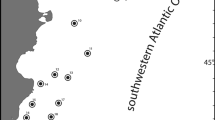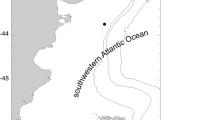Abstract
Holothuroids of family Cucumariidae are known to brood their young, and several species from Southern Oceans present different brooding mechanisms, indicating the heterogeneity of this family in this regard. Since few reports analyze the brooding in this family, we studied the reproduction and development of brooders, in the cucumariid Cladodactyla crocea (Lesson, 1830), based on samples taken on several cruises between 38° and 55° up to 1738 m depth, from September 2009 to October 2016. Brooder specimens develop a dorsal marsupium where uncleaved eggs of about 0.94 mm are released in the fall and brooded, until juveniles are released in the following spring. Unreleased eggs of about 0.93 mm were also found in the fall, in the gonads. In addition, in the spring samples, we found ten specimens with 15 cleaved eggs of about 1.1 mm and 34 specimens with 2–35 brooded juveniles, in adults of 14.0–20.0 mm of length. Several adults had up to three different developmental stages at the same time: young pentactula (about 1.6 mm), pentactula (about 1.8 mm), and early juveniles (about 2.2 mm). The external brooding behavior of C. crocea is consistent with the observations made for other species of Cucumariidae in South America and Antarctica. Brooding is a common feature in species of Cucumariidae from the Southern Hemisphere. External brooding is common in South America and Antarctica specimens, while internal brooding has multiple examples in Australia and New Zealand. These different brooding strategies are discussed after the observations made in C. crocea.



Similar content being viewed by others
References
Alcock N, O´Loughlin PM (2001) Brood-protection by the New Zealand cucumariid Squamocnus niveus (Echinodermata, Holothuroidea). In: Barker M (ed) Echinoderms 2000. Balkema, Dunedin, pp 331–333
Andreo VC, Dogliotti AI, Tauro CB (2016) Remote sensing of phytoplankton blooms in the continental shelf and shelf-break of Argentina: spatio-temporal changes and phenology. IEEE J Sel Topics Appl Earth Observ Remote Sens 9(12):5315–5324
Bell FJ (1908) Echinoderma. In: Bell FJ (ed) National antarctic expedition 1901–1904, natural history, IV zoology. The British Museum, London, pp 1–16
Bohn JM (2007) Pseudrotasfer microincubator gen. et spec. nov., a brooding cucumariid holothurian (Echinodermata: Holothuroidea: Dendrochirotida) from the Burdwood Bank (south-western Atlantic Ocean). Zootaxa 1662:61–68
Bohn JM, Heß M (2014) The Antarctic holothurian genus Echinopsolus Gutt, 1990 (Dendrochirotida, Cucumariidae): brood pouches, spermatozoa, spermatozeugmata and taxonomic implications. Zootaxa 3841:573–591
Brogger MI, Gil DG, Rubilar T, Martinez MI, Díaz de Vivar E, Escolar M, Epherra L, Pérez AF, Tablado A (2013) Echinoderms from Argentina: biodiversity, distribution and current state of knowledge. In: Alvarado JJ, Solís-Marín FA (eds) Echinoderms research and diversity in Latin America. Springer, Berlin, pp 359–402
Burmeister H (1837) Handbuch der Naturgeschichte [Part 2] xii. Enslin, Berlin, pp 369–858
Ekman S (1925) Holothurien. In: Odhner T (ed) Further zoological results of the Swedish Antarctic Expedition 1901–1903 I(6). PA Norstedt & Söner, Stockholm, pp 1–194
Ekman S (1927) Holothurien der Deutschen Südpolar-expedition 1901–1903 aus der Ostantarktis und von den Kerguelen. In: Drygalski E von (ed), Deutsche Südpolar-expedition 1901–1903. 19(9), [= Zoologie 11(9)], de Gruyter, Berlin, Leipzig, pp 359–419
Gillespie JM, McClintock JB (2007) Brooding in echinoderms: how can modern experimental techniques add to our historical perspective? J Exp Mar Biol Ecol 342:191–201
Lesson RP (1830) Centurie zoologique ou choix d´animaux rares. Nouveaux ou Imparfaitement Connus, Levrault
Ludwig H (1875) Beitrage zur Kenntniss der Holothurien. Arbeiten aus zoolog zootom Inst Würzburg 2(2):77–120
Ludwig H (1883) Verzeichniss der Holothurien des Kieler Museums. Ber Oberhess Ges Natur- und Heilk 22:155–176
Ludwig H (1898) Holothurien. Ergebnisse der Hamburger Magalhaensischen Sammelreise 1892/93 L. Friederichsen and Co, Hamburg
Ludwig H (1904) Brutpflege bei Echinodermen. Zool Jb Suppl VII:683–699
Martinez MI, Brogger MI (2012) Thandarum hernandezi, a new genus and new species of sea cucumber family Sclerodactylidae (Echinodermata: Holothuroidea: Dendrochirotida) from the Southwestern Atlantic Ocean. Zootaxa 3304:63–68
Martinez MI, Penchaszadeh PE (2017) A new species of brooding Psolidae (Echinodermata: Holothuroidea) from deep-sea off Argentina, Southwestern Atlantic Ocean. Deep-Sea Res II 146:13–17. https://doi.org/10.1016/j.dsr2.2017.05.007
Martinez MI, Thandar AS, Penchaszadeh PE (2013) A new species of Havelockia Pearson, 1903 from the Argentine Sea (Holothuroidea: Dendrochirotida: Sclerodactylidae). Zootaxa 3609:583–588
Martinez MI, Solís-Marín FA, Penchaszadeh PE (2014) Benthodytes violeta, a new species of a deep-sea holothuroid (Elasipodida: Psychropotidae) from Mar del Plata Canyon (south-western Atlantic Ocean). Zootaxa 3760:89–95
McEuen FS, Chia F-S (1991) Development and metamorphosis of two psolid sea cucumbers, Psolus chitonoides and Psolidium bullatum, with a review of reproductive patterns in the family Psolidae (Holothuroidea: Echinodermata). Mar Biol 109:267–279
O´Loughlin PM (1994) Brood-protecting and fissiparous cucumariids (Echinodermata, Holothurioidea). In: David B, Guille A, Féral J-P, Roux M (eds) Proceedings of the eighth international Echinoderm Conference. Balkema, Dijon, pp 539–547
O´Loughlin PM, O´Hara TD (1992) New Cucumariid Holothurians (Echinodermata) from Southern Australia, including two brooding and one fissiparous species. Mem Mus Vic 53:227–266
O´Loughlin PM, Eichler J, Altoff L, Falconer A, Mackenzie M, Whitfield E, Rowley C (2009) Observations of reproductive strategies for some dendrochirotid holothuroids (Echinodermata: Holothuroidea: Dendrochirotida). Mem Mus Vic 66:215–220
O´Loughlin PM, Stępień A, Kuźniak M, Van den Spiegel D (2013) A new genus and four new species of sea cucumbers (Echinodermata) from Admiralty Bay, King George Island. Pol Polar Res 34:67–86
O´Loughlin PM, Mackenzie M, Paulay G, Vandenspiegel D (2014) Four new species and a new genus of Antarctic sea cucumbers with taxonomic reviews of Cladodactyla, Pseudocnus, Paracucumidae and Parathyonidium (Echinodermata: Holothuroidea: Dendrochirotida). Mem Mus Vic 72:31–61
Pawson DL (1964) The Holothuroidea collected by the royal society expedition to Southern Chile, 1958–1959. Pac Sci 18:453–470
Pearse JS (1994) Cold water echinoderms break ‘‘Thorson’s Rule’’. In: Young CM, Eckelbarger KJ (eds) Reproduction, larval biology, and recruitment of the deep-sea benthos. Columbia University Press, New York, pp 27–43
Pearse JS, Mooi R, Lockhart SJ, Brandt A (2009) Brooding and species diversity in the Southern Ocean: Selection for brooders or speciation within brooding clades? In: Krupnik I, Lang MA, Miller SE (eds) Smithsonian at the poles. Smithsonian Institution Scholarly Press, Washington DC, pp 181–196
Semper C (1867–1868) Holothurien. In: Semper C (ed) Reisen im Archipel der Philippinen. Zweiter Theil. Wissenschaftliche Resultate. Erster Band. W. Engelmann, Leipzig, pp 1–288
Studer T (1880) Über Geschlechtsdimorphismus bei Echinodermen (Schluss). Zool Anz III 68:543–546
Thomson CW (1876) Notice of some peculiarities in the mode of propagation of certain Echinoderms of the Southern Sea. J Linn Soc 13:55–79
Thorson G (1950) Reproductive and larval ecology of marine bottom invertebrates. Biol Rev 25:1–45
Vaney C (1925) L´incubation chez les Holothuries. Travaux de la Station Zoologique de Wimereux Tome 9:254–274
Acknowledgements
The authors would like to express their gratitude to the colleagues on board the B/O Puerto Deseado during different cruises along the Argentine coast; especially Carlos Sánchez Antelo, Juan José Berecoechea, Pamela Rivadeneira, Jonathan Flores, and Martín Brogger. We thank Fabian Tricarico for the assistance with the SEM. Also we would like to thank John Lawrence, Mike Reich, Dieter Piepenburg, and three anonymous reviewers, for valuable suggestions and commentaries that improved this manuscript. This work was partially founded by PICT 2013-2504, PICT 2015-0428, and PICT 2016-0271 from the Agencia Nacional de Promoción Científica y Tecnológica.
Author information
Authors and Affiliations
Corresponding author
Ethics declarations
Conflict of interest
The authors declare that they have no conflict of interest.
Rights and permissions
About this article
Cite this article
Martinez, M.I., Alba-Posse, E.J., Lauretta, D. et al. Developmental stages in the brooding sea cucumber Cladodactyla crocea (Lesson, 1830) in the southwestern Atlantic Ocean. Polar Biol 41, 1237–1244 (2018). https://doi.org/10.1007/s00300-018-2280-y
Received:
Revised:
Accepted:
Published:
Issue Date:
DOI: https://doi.org/10.1007/s00300-018-2280-y




